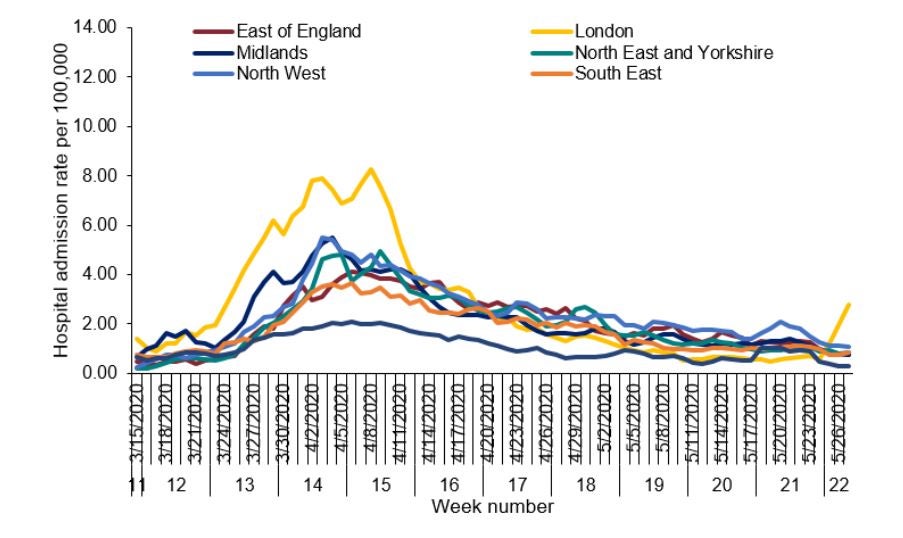Coronavirus cases see small increase and hospital admissions rise as UK lockdown relaxed
London sees significant spike in hospital admissions for patients with Covid-19
Your support helps us to tell the story
From reproductive rights to climate change to Big Tech, The Independent is on the ground when the story is developing. Whether it's investigating the financials of Elon Musk's pro-Trump PAC or producing our latest documentary, 'The A Word', which shines a light on the American women fighting for reproductive rights, we know how important it is to parse out the facts from the messaging.
At such a critical moment in US history, we need reporters on the ground. Your donation allows us to keep sending journalists to speak to both sides of the story.
The Independent is trusted by Americans across the entire political spectrum. And unlike many other quality news outlets, we choose not to lock Americans out of our reporting and analysis with paywalls. We believe quality journalism should be available to everyone, paid for by those who can afford it.
Your support makes all the difference.New data has shown the number of coronavirus patients being admitted to hospital and intensive care units across the country has risen as lockdown rules are set to be eased further on Monday.
The Public Health England (PHE) data, published on Friday, covers 134 NHS trusts across the country and shows the daily rate of new patients admitted to hospital and critical care with Covid-19 has risen compared to recent weeks, with London experiencing a sharp spike in new admissions in the past week. The south east region also saw an increase.
The surveillance data on the spread of Covid-19 throughout England has also revealed an increase in the number of people testing positive at their GP.
PHE said the results needed to be treated with caution as more samples for the past week could affect the overall result.
It said: “Up to 27 May, the daily admission rates for both hospitalisations and ICU/HDU Covid-19 admissions have increased slightly. By NHS regions, the highest hospitalisation and ICU/HDU rates were observed in London.”

It comes as three members of the government’s scientific advisory group, SAGE, have criticised plans to relax lockdown rules on Monday warning it is too early.
From Monday up to six people will be able to meet in gardens and outdoor spaces and the government is preparing for more shops to open from 15 June.
In its report PHE said overall across the country “most Covid-19 surveillance indicators have declined or remained at similar levels to the previous week. Activity is highest in the North and central regions of England.”
Since February around 200 GP practices across the country have been taking samples from patients with respiratory infections who are not suspected of having coronavirus.
PHE said: “Up to 27 May 2020, a total of 4,158 patients have been tested of which 575 have tested positive for SARS-CoV-2 through this scheme. The overall positivity increased at 10.8 per cent (10/93) in week 20 [11-17 March] compared to 3.6 per cent (9/250) in the previous week.”
Again it said more results for the most recent week may change the overall results in coming days.
PHE said it had recorded 264 new respiratory infection outbreaks in the most recent week. An outbreak is defined as two or more people who are infected with the cases linked to a specific location.
A total of 215 outbreaks were in care homes where 78 tested positive for Covid-19. Another 13 outbreaks were linked to hospitals where 12 were positive for coronavirus. There were three outbreaks in schools where all were positive for the virus.
PHE is also testing thousands of blood samples from blood donors across England to determine how widespread the virus is across England.
It said overall the prevalence in London had increased to almost 15 per cent earlier in May although it said the increases were slower than those seen in April.
It said: “Given that the antibody response takes at least two weeks to become detectable, those displaying a positive result in week 18 are likely to have become infected before mid-April. As the incidence in this period may only have just begun to slow following the impact of lockdown measures, this may explain the slight increase over that period.”
It added: “The adjusted prevalence in North East and North West regions in weeks 16 [13-19 April] is well above baseline (3.5 per cent and 5.3 per cent respectively), higher than in London and the Midlands in week 14 [30 March to 5 April], but not as high as seen in London in week 16, which is consistent with the surveillance trends reported for England.”
The highest prevalence in all regions was typically among young people aged between 17 and 29-years-old. This reached as high as almost 17 per cent in the North West region.

Join our commenting forum
Join thought-provoking conversations, follow other Independent readers and see their replies
Comments